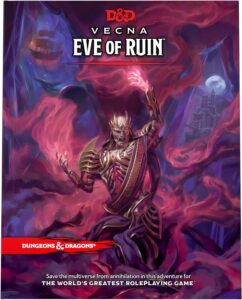As I write this, it’s the early access release day of Vecna: Eve of Ruin. Except, of course, I’m in Australia, and it’s still the day before in the US. So, it isn’t out yet. I’m not entirely sure when it will go live. Perhaps in 17 hours when I’m asleep?
For the first few years of this edition, I was incredibly excited whenever a new adventure came out. We played all of them in my local store, with lots of people participating. It’s been a while since I felt that excited. Partly it’s because there are so many now, but it’s also been partly due to Wizards fumbling so many releases. The half-baked Dragon Heist, the unbaked Descent into Avernus. And the “what were you thinking?” Shattered Obelisk.
Each of these has been disappointing in different ways. I’ve run Dragon Heist three times, and there’s a lot in it that I’d be happy to go back to, but taken as a whole, it’s a mess. I am not that fond of Descent into Avernus. And while the underlying design of The Shattered Obelisk isn’t as flawed as those other titles, it shows a distinct lack of ambition – or more correctly, competence to realise its ambition. (“Mildly odd” is not a feeling the Far Realm should provoke in me).
All of which means that I’m am extremely apprehensive about how they’ll go with Vecna: Eve of Ruin.
The basic structure (multiverse trotting to different settings to retrieve parts of the Rod of Seven Parts) sounds functional but not exciting. Why not exciting? I think involving the Rod is really exciting, but I’m very dubious about the different settings. I have a feeling it puts a lot on the DM’s shoulders to evoke the character of each of these places. (A few of my friends are rather unimpressed that the location for the Dragonlance segment is a place no-one has heard of before.)
Does this mean it’ll be bad? Nah. It could be glorious. But I’m going in with a low level of expectations.
I’m at my happiest when adventures open up to allow the players agency, even while keeping an overall linear structure. Tyranny of Dragons ranks very highly for me because of this – there are lots of time where I know where the end point of a situation is, but no idea how the players will handle it. Dragon Heist, for all its flaws, also has this feature. The players owning a tavern and going on missions for factions is just bursting with possibilities. It’s entirely possible to run a campaign that never gets to Chapter 3, just because you’re having so much fun building out Waterdeep and its inhabitants.
This is, indeed, one of my bigger problems with The Shattered Obelisk. We have, in Lost Mine of Phandelver, a town that can be expanded. Lots of interesting NPCs (several with ties to factions, which makes them repeatable quest-givers). The D&D Essentials Kit gave as an idea of how it could go, with a lot more quests using Phandalin as a hub.
And in The Shattered Obelisk, it walks away from this set-up. Most of the NPCs are not mentioned, and those that are used are underserved with content. To make things worse, it introduces a brand new NPC to be the primary source of information for the players rather than using an established NPC. (There isn’t all that much content for the NPC either).
During the final chapter, when the actual Bad Things Happen in Phandalin, which should give the players extra motivation for stopping the Big Bad, the heroes don’t return to Phandalin! (The adventure even notes this is the case).
Not Returning To Town is a problem that is, in fact, not new to D&D 5E. One of the earliest strands of play was making short expeditions into a dungeon and returning to town to restock and resupply, and that strand happily continues today. However, once you get quest after quest that leads you away from town, it’s very easy to have a campaign structure that never requires returning. Especially when spells can negate the need for resources.
But all of this means that Phandalin doesn’t feel like it’s an expanding town of possibilities for the characters. And each of the other locations they explore tend to be linear and limited. There are a couple of exceptions, but they tend not to be bursting with content.
My fear is that Eve of Ruin will have these limited play areas – one goal, linear approach, and no alternative ways for the players to experiment with. Is the fear justified? I guess we’ll see soon!

